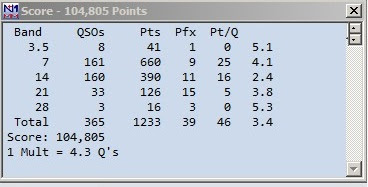 |
| W Q 6 X operating from Alameda + Stat Screen Collage |
The last weekend in April is relatively quiet, radiosport-wise. For this last weekend there were
3 radiosport competitions which I deemed worthy of further investigation:
- [?] - SP-DX RTTY Contest
- [?] - Helvetia Contest
- [?] - The FL QSO Party (FQP)
For this weekend, the Helvetia contest was another no-show disappointment @NX6T in Fallbrook. Last year (2018), evidently I was off doing other things as there is no evidence of any WQ6X radiosport activity in the above events. In 2017 while WQ6X worked both the Helvetia and
SP-DX contests for the 1st time, they were on different weekends in April.
Also on this weekend Japanese amateurs were holding their own regional contest (similar to
the Russian's domestic GiG the weekend before). This populated the bandmap with 100's of unworkable JA stations (many of the signals being S9+ on 40 meters and S3 - S5 on 80). One way of solving this "problem" is by changing the TELNET settings, taking the unworkable JA calls
out of the band map. Then again, leaving them IN the bandmap makes it easier to avoid that area
of the Cw spectrum while tuning around.
 |
| W Q 6 X running N X 6 T's STN-1 in Fallbrook remotely |
To guarantee QSOs in the LoG, the decision was made to run high power (990 watts) into the C-31 yagi (for the high bands), a 2-el Shorty-40 and a 13mh inverted Vee for 80. FQP doesn't run 80-meters, leaving the Vee for the SP-DX Rtty.
While FQP began at 16:00z, because the main focus was RTTY, switching over to Cw didn't happen until 22;30z on 20 meters; altho earlier a periodic look at 10 & 15 meters yielded no Florida stations - Bummer Dewd!
Anticipating working Asian station on RTTY (each contact worth 10 points),
I turned to the Russian Letter Beacons (7.039 Mhz) for an idea of how propagation to Asia might turn out.
As it turns out, the resultant predictions turned out to be relatively accurate. Pointing the antenna to 320-degrees yielded scores of JA & UA0 stations. A number of surprise calls came from stations like: 9M2, 8N3, YB7, YC4, BA5, BH6 & HL5; the last contact in the log being with DU1/N6NPX.
From this last weekend I have 2 radiosport beefs; one from FQP and one from the RTTY contest. There were MANY non-4 stations operating from Florida this year. While that is nice, unless I asked them SPECIFICALLY, I had NO WAY of knowing they are in Florida. There are 2 solutions to this dilemma; signing /4 is an obvious one. An even better solution is to add the 3-char county abbv. to your callsign, as the rover stations do, making our job easier and putting MORE QSOs in their logs. For example: if WQ6X were to run from Miami-Dade, the CQ would look like: CQ FQP WQ6X/DAD WQ6X/DAD. BTW, most RTTY contests would REQUIRE WQ6X to sign /4 ; i.e. WQ6X/4.
In RTTY contests one of my BEEFS
is stations who jump on my frequency EXACTLY, as if they didn't know I was there. In a Cw contest, being NEAR
my run frequency is understandable.
EXACTness (down to 1hz) is
NO ACCIDENT. SPECIFIC run frequencies are purposely chosen
(such as 14085.85 or 7047.47) .
Getting PERFECT copy on the RTTY decoding, I know the offending station HEARD ME FIRST before they decided to attempt grabbing the frequency.
This weekend offered up an opportunity to give another test to the rerouted audio cables to the Autek QF-1A
and MFJ-751 analog audio filters.
Because these filters occur on the remote side of the connection, they are no good for Rtty decoding; luckily
the Elecraft K3's Shift/Width/DSP circuits handle most
of the required filtering. However, for Cw, this filter combination is outstanding. Properly adjusted, the resultant "Stereo-Cw" effect is an unbeatable combination. ([
CLICK HERE] to read the recent
BLOG I wrote on this useful filter side-effect.)
When adjacent channel RTTY stations move in, with this filter combination, the RTTY audio of the nearby stations is attenuated considerably, saving my ears (and sanity)
at the very least.
Overall, this was a successful contest weekend. While I managed to S&P a few multipliers into the RTTY log, the secret to this weekend was to find
quiet frequencies to run.
In contest events like the FQP, being an out-of-state station, running frequencies is not necessary.
Thanks to Stereo-Cw concept coupled with the Elecraft K3/0's R-I-T control, each station to work is easily "moved" into the audio passband for near-perfect copy that even the K3's DSP can't do any better.
Did YOU work the SP-DX RTTY contest and Florida QSO Party?
Is WQ6X in YOUR LoG?












































